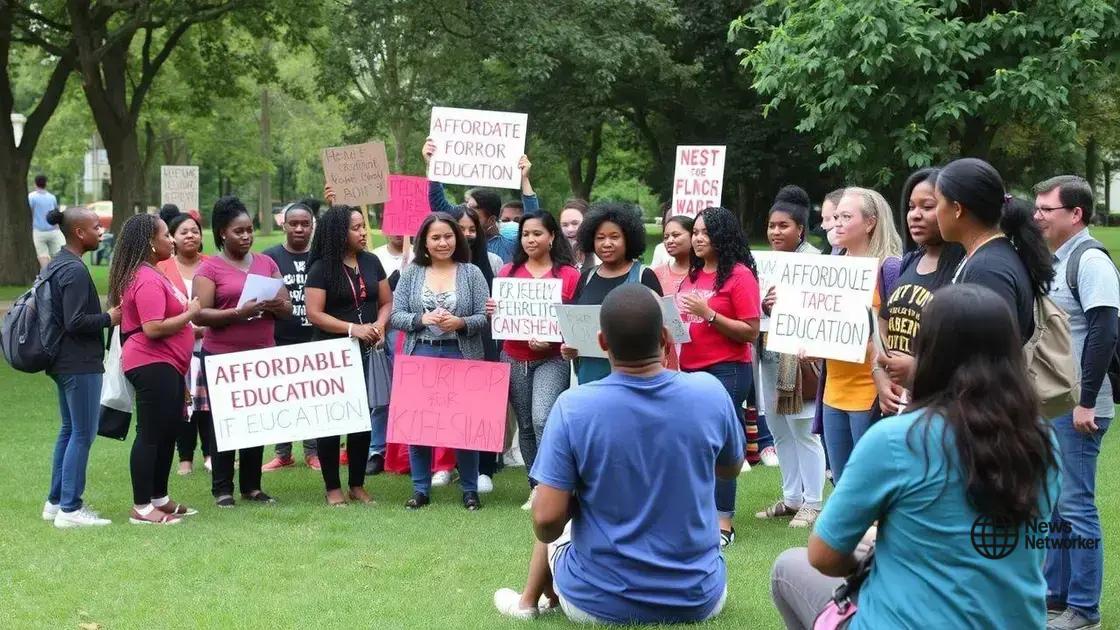March for affordable education: fighting for change

The March for affordable education focuses on mobilizing communities, sharing success stories, and advocating for policy changes to ensure access to education without overwhelming debt.
March for affordable education is a call to action that resonates with many who seek better access to learning opportunities. Imagine being part of a movement that aims to make education accessible for everyone. Ready to dive in?
Understanding the need for affordable education
Understanding the need for affordable education is crucial for creating a fair and accessible learning environment for all. Today, millions of students face financial barriers that hinder their educational pursuits. When education costs rise, many talented individuals are forced to forgo their dreams due to burdening debt.
The impact of high tuition fees
High tuition fees can lead to significant student debt for many graduates. This debt can impact their future choices, from career opportunities to home ownership. Students often feel pressured to choose fields based on potential income rather than passion.
- Over 44 million Americans currently hold student loans.
- The average student debt for a graduate is around $30,000.
- High student debt can lead to mental health issues and financial anxiety.
Moreover, the financial strain on families contributes to economic disparity. While some students can afford elite universities, others are left with limited options. This scenario fosters an environment of inequality, making it essential to advocate for affordable education.
Why affordable education matters
Educational equity is vital for the growth of society. When education is affordable, more individuals can pursue their academic interests and contribute positively to their communities. It encourages diversity in higher education and allows innovation to thrive.
Affordable education also benefits the economy in the long term. A more educated workforce leads to better job performance and productivity. As more people gain access to education, overall economic growth occurs, creating thriving communities.
The impact of student debt on young adults
The impact of student debt on young adults is profound and far-reaching. Many graduates find themselves burdened by massive debts that affect their personal and professional lives. This financial strain can lead to significant consequences.
Financial decisions influenced by debt
Student debt alters young adults’ financial priorities. Instead of saving for a home or investing in their future, many are forced to allocate a large portion of their income to loan repayments. This can lead to delays in major life milestones, such as starting a family or purchasing a home.
- 70% of graduates report changing their career choices due to debt.
- Many young adults prioritize debt repayment over pursuing further education.
- Student loans often prevent savings for emergencies or retirement.
Moreover, the mental health effects of student debt cannot be overlooked. The anxiety stemming from financial pressures can lead to stress, depression, and feelings of helplessness. As debt mounts, many young adults feel trapped, unsure of how to improve their situation.
Long-term economic effects
The wider economic ramifications of student debt are significant as well. When young adults are unable to buy homes or invest in businesses, the economy suffers. This reduces consumer spending and slows economic growth.
In addition to individual consequences, rising student debt levels can strain the economy. Policymakers are increasingly recognizing the need for reform to address this crisis. Unaddressed, the cycle of debt impacts not only those with student loans but the economy as a whole.
Mobilizing communities for the cause

Mobilizing communities for the affordable education cause is essential. By bringing people together, we can create a powerful movement that advocates for change. Community engagement can amplify our voices and ensure that education remains accessible to all.
Building awareness and support
Communities can start by raising awareness about the challenges that students face due to high tuition fees. Organizing informational sessions helps spread the message. Local events, workshops, and social media campaigns can educate community members about the importance of affordable education.
- Host forums where students share their experiences.
- Create informative materials like brochures and social media posts.
- Encourage local leaders to voice support for educational reform.
Engaging with local businesses and organizations can also strengthen these efforts. Partnerships with community leaders can foster deeper connections and broaden the reach of the message.
Getting involved and taking action
Encouraging community members to take action is vital. Simple steps can lead to significant impact. Community members can participate in protests, volunteer for local organizations, or even organize their own events to advocate for change.
A productive way to mobilize is by forming coalitions. Groups united in the push for affordable education can pool resources and ideas. This collaborative approach makes efforts more effective.
Involving young people in these initiatives will ignite passion and commitment. It’s essential to inspire the next generation to advocate for the education they deserve. Together, communities can create a lasting impact.
Strategies to advocate for policy changes
Advocating for policy changes is essential in the fight for affordable education. By employing effective strategies, communities and individuals can make their voices heard. These actions can lead to significant reforms in educational policies, benefiting countless students.
Understanding the political landscape
To advocate successfully, it’s crucial to understand the political landscape. Knowing who the key decision-makers are is the first step. Engaging with local representatives can provide insight into potential opportunities for change.
- Research state and local education policies.
- Identify lawmakers who support affordable education.
- Build relationships with education advocacy organizations.
Gathering data to support your claims can strengthen your position. Providing statistics and personal stories illustrates the need for change effectively.
Building coalitions and networks
Forming coalitions with like-minded groups amplifies your message. When organizations unite, they increase the visibility of their cause. Collaborating on campaigns or rallies can draw more attention to the need for policy changes.
Networking with other advocates also fosters knowledge sharing. By learning from one another’s experiences, groups can develop more effective strategies. Direct outreach and organizing community forums can showcase the importance of affordable education and its impact on students.
Ultimately, persistence is key. Policy changes take time, but consistent advocacy ensures that the issue remains a priority on the political agenda.
Success stories from around the country
Success stories from around the country highlight the impact of advocating for affordable education. These examples show how community efforts can lead to significant changes in educational policies and access.
Grassroots movements making a difference
In several states, grassroots movements have successfully lobbied for lower tuition fees. Volunteers organized rallies and outreach campaigns, gathering thousands of supporters. This united front caught the attention of lawmakers, prompting them to reconsider their positions on funding.
- One notable campaign reduced state university tuition by 20% in just two years.
- Community colleges have increased enrollment rates by offering scholarships funded by local businesses.
- A grassroots group helped pass a bill to create a loan forgiveness program for educators.
These movements often begin with small groups of dedicated individuals who recognize the need for change. Through persistence and strategic action, they can inspire others to join the cause.
Empowering students through success stories
Hearing firsthand accounts from students who benefited from affordable education initiatives is powerful. Many students have shared how they overcame financial hardships to pursue their dreams. These narratives serve as motivation for others facing similar challenges.
One story is that of a young woman who became the first in her family to graduate from college. Thanks to a scholarship program, she accessed higher education without the burden of debt. Her achievement inspired her siblings and peers to seek similar opportunities.
Such success stories not only highlight individual triumphs but also emphasize the collective impact of affordable education movements. By celebrating these successes, communities continue to build momentum toward further change.
FAQ – Frequently Asked Questions about Affordable Education
What are grassroots movements and how do they help?
Grassroots movements are community-led efforts that mobilize people to advocate for changes in educational policies, making education more accessible.
How can success stories impact the movement for affordable education?
Success stories inspire others by showcasing real-life examples of individuals who have benefited from affordable education initiatives, motivating further advocacy.
What role do community organizations play in advocating for policy changes?
Community organizations help unite individuals and amplify their voices, making it easier to push for policy changes that support affordable education.
Why is collective action important in this movement?
Collective action strengthens the movement by bringing together diverse voices and resources, increasing the likelihood of achieving meaningful changes in education policies.





